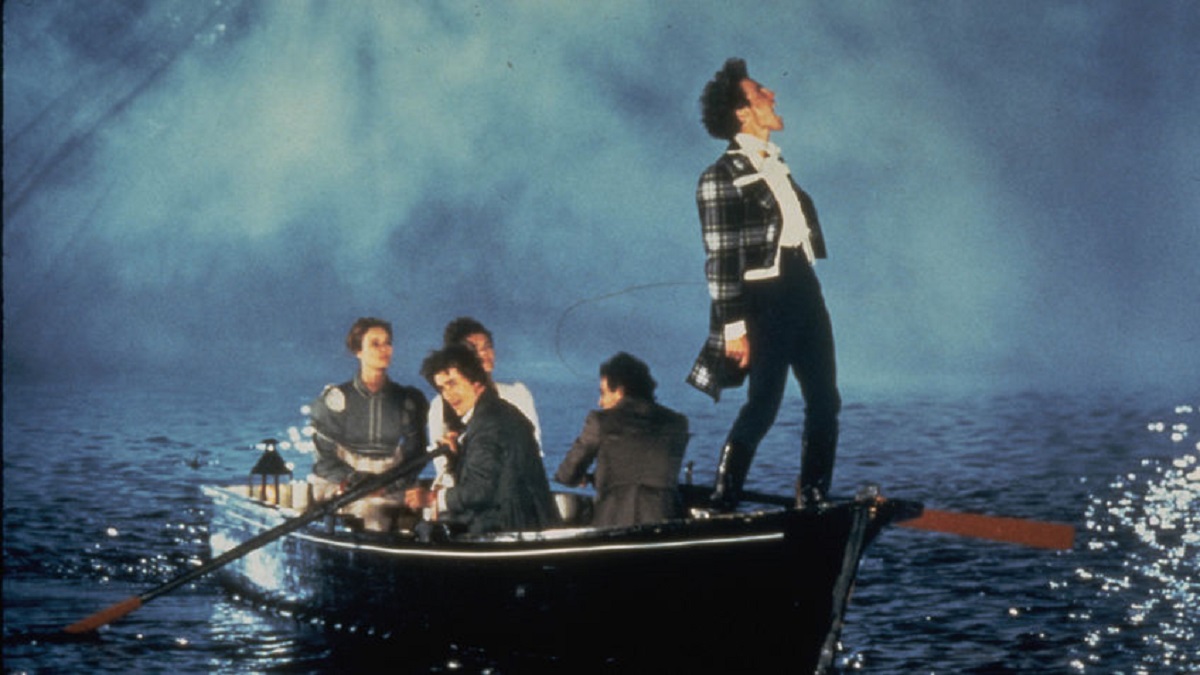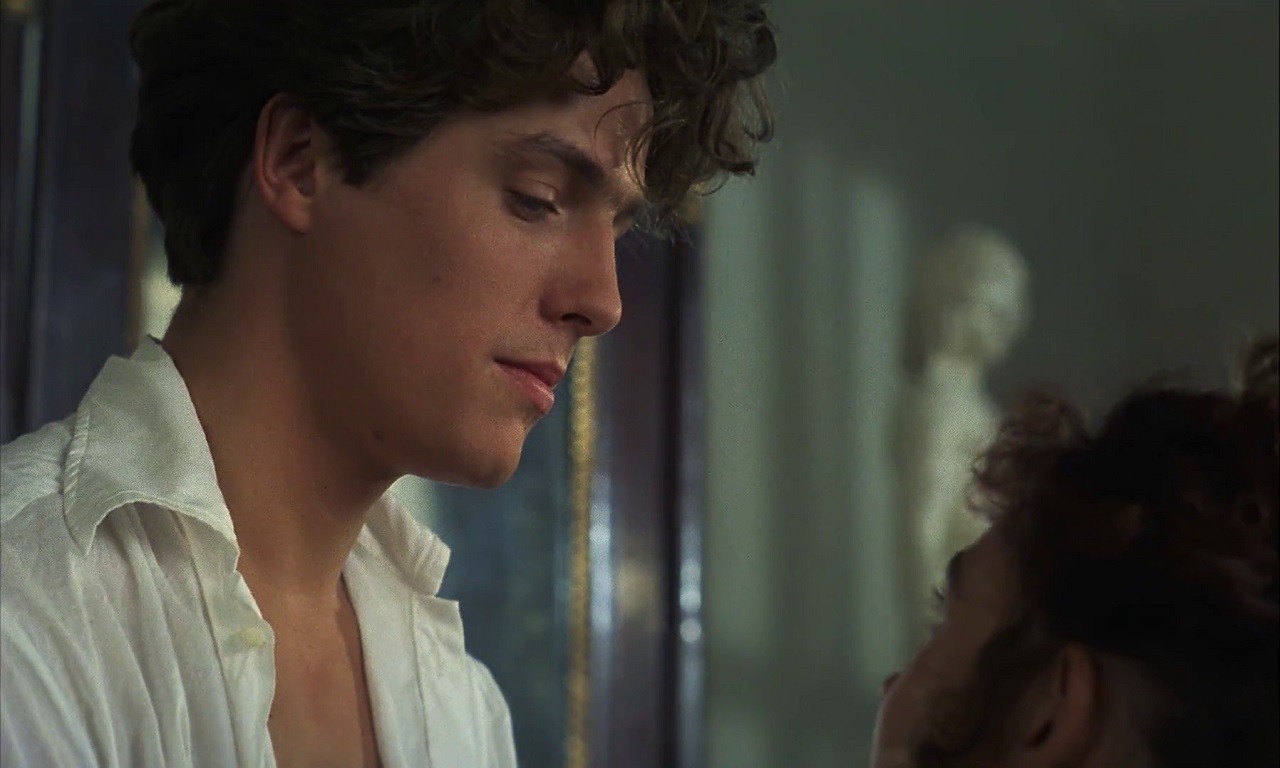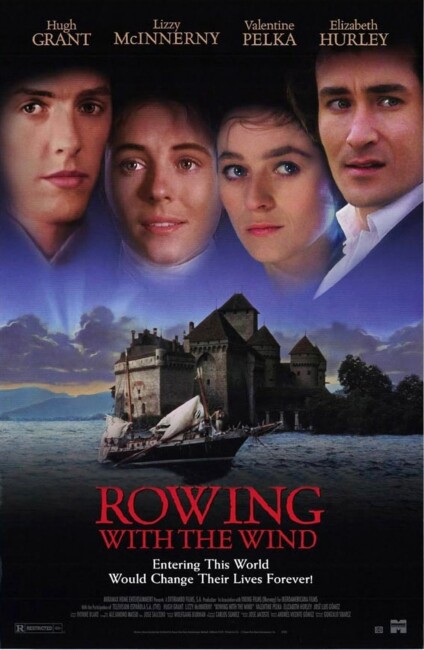(Remando al Viento)
Spain. 1988.
Crew
Director/Screenplay – Gonzalo Suarez, Photography – Carlos Suarez, Music – Alejandro Masso, Special Effects – Reyes Abades & Fernando Perez, Production Design – Wolfgang Burman. Production Company – CIA. Iberoamericana de TV,. SA./Viking Film A-S/Ditirambo Films, S.A./Television Espanola (TVE, S.A.).
Cast
Hugh Grant (Lord Byron), Valentine Pelka (Percy Bysshe Shelley), Lizzy McInnerny (Mary Wollstonecraft Shelley), Elizabeth Hurley (Claire Clairmont), Jose Luis Gomez (Dr Polidori), Ronan Vibert (Fletcher), Jolyon Baker (Edward Williams), Terry Taplin (William Godwin), Nicolas Moser (William Shelley), Rebeca Odovas (Allegra Byron), Virginia Mataix (Elisa), Kate McKenzie (Jane Williams), Bibi Andersen (Fornarina)
Plot
1816. The English poet Percy Bysshe Shelley travels to Switzerland, accompanied by his lover Mary Wollstonecraft and Mary’s half-sister Claire Clairmont. Claire is infatuated with the poet Lord Byron and persuades them to visit Byron at the villa he rents. As they luxuriate, Mary is inspired to write a horror story. Back in England, she publishes this as Frankenstein to great success. However, as she and Percy have a son William and Claire gives birth to Byron’s daughter Allegra, Mary realises that she has given life to a creature that will bring tragedy to all their lives.
Rowing with the Wind came out amid a cluster of films in the late 1980s centred around the events of the summer of 1816 where the poet Percy Bysshe Shelley and his lover Mary Wollstonecraft (later better known as Mary Shelley) and her half-sister Claire Clairmont went to visit Lord Byron and his physician Dr John Polidori at the Villa Diodati that Byron had rented on the shores of Lake Geneva. The visit led to the writing of two of the formative works of the horror genre – Mary Shelley’s Frankenstein (1818) and Polidori’s The Vampyre (1819), the first work of fiction work about a vampire.
The late 1980s brought several films centred around the events at the Villa Diodati with Ken Russell’s Gothic (1986), followed by the US-made Haunted Summer (1988). There was also this Spanish production, the least well-known of the films. This was followed by Roger Corman’s Frankenstein Unbound (1990) in which John Hurt goes back in time to the Villa Diodati and meets both Mary Shelley and Frankenstein and his monster. A few years later, the same events were also depicted in the biopic Mary Shelley (2017), A Nightmare Wakes (2020) and the Doctor Who episode The Haunting of Villa Diodati (2020) where the apparition that Mary sees turns out to be a Cyberman.
Spanish director Gonzalo Suarez has dabbled with various genre works and classical adaptations. His other films of genre note include:- The Strange Case of Dr Fausto (1969), an adaptation of the Faust story; Aoom (1970) where a man transfers his mind into a doll; the thriller Morbidness (1972); the Old Dark House thriller House of the Damned/The Wolf and the Dove (1974); the horror film Beatriz (1976); Don Juan in Hell (1991); the surreal horror film The Detective and Death (1994); and Oveido Express (2007) about a strange performing troupe.

Rowing with the Wind is notable in retrospect for starring Hugh Grant who was at this point was not quite the celebrity he became a few years later after the success of Four Weddings and a Funeral (1994). Grant makes for an okay Lord Byron, playing with a dashing handsomeness and the perfectly mannered polish he always does. On the other hand, Byron is historically characterised with a dark, brooding charisma but this is not quite something present in Grant’s performance. (In its favour, this is the only of the four Villa Diodati films from this era that give Byron his limp). Rowing with the Wind is also notable as being where Grant and Elizabeth Hurley met and sparked up a relationship in real-life that lasted until 2000 and was the subject of much paparazzi focus. Hurley is okay in the role of the Byron-obsessed Claire Clairmont.
Gonzalo Suarez’s version of the Villa Diodati story is more accurate than some of the other versions, less so than the actual facts. It gets the roles between the principals in ways that one feels is right, especially Claire’s obsession with Byron that led the group to the villa and was downplayed by all the other films of this period. The most egregious change is that Polidori is made into what would seem to be an Italian character when in fact he was English, Moreover, the role is played by Spanish actor Jose Luis Gomez who was 48 at the time, whereas Polidori was only twenty-one in 1816. The film also has Polidori committing suicide at the Villa whereas he did not die until 1821, five years after the events that happened at the villa (in what may or may not have been a suicide).
Rowing with the Wind is also the only of the Villa Deodati films to open the story up beyond the events of 1816, taking us through Mary’s publication of Frankenstein, the birth of Allegra and eventually to Percy’s death in a yachting accident in 1822. The film winds in many other biographical details that the other films neglect – the death of William; Allegra, Claire’s daughter to Byron, who is placed in a convent school by Byron where she dies at the age of five; Percy’s befriending of Edward Williams and sharing of an Italian villa with him; Percy’s death at sea and subsequent funeral on a beach. The film also shows frequent disregard for the historical facts – Shelley is made to seem much more wealthy than he was; Percy and Mary’s son William was born before the events of 1816, not after as the film has it, and should have been present at the villa, while their other children have been written out. The film also has a publisher approaching Mary in a restaurant to talk about her book when in fact she was never credited as the author of Frankenstein until 1832, which would be several years after the film’s timeframe.

Gonzalo Suarez is not particularly attuned to the drama taking place at the villa. Although part of this is that the current dvd version of the film runs far shorter than the credited runtimes of the film – the Blu-Ray runs to 95 minutes, whereas the film’s original theatrical release ran to 102 minutes and the Spanish original is listed as 126 minutes, meaning that the film in current circulation is missing something like 30 minutes from the original print. Certainly, Suarez does offer up some gloriously decadent images – Byron and Shelley launching a miniature hot air balloon and then taking pot shots with pistols to shoot it down; or the visit to Byron in Ravenna where a giraffe casually drifts through the house in the background.
One of the more unusual aspects of the film is that Gonzalo Suarez winds in appearances from the Frankenstein monster (the actor playing the role is not credited). It is variously seen lurking around and appears like a harbinger that seems to foretell the deaths of the various characters and their children. You get the impression that it is an allegorical figure in Mary’s imagination – at some points it is something that only Mary sees but in other scenes it appears when she is not present and is seen interacting with William. Later she voices the idea that it is something that she gave birth to, although it is not clear if she is talking literally or allegorically.
Trailer here (no English subs)


